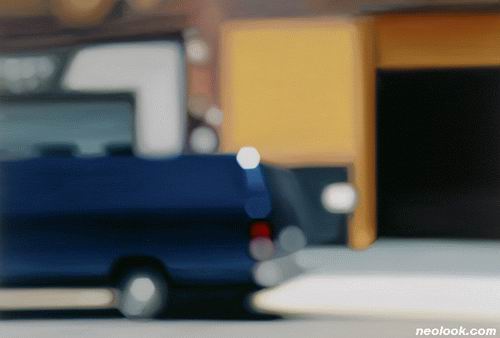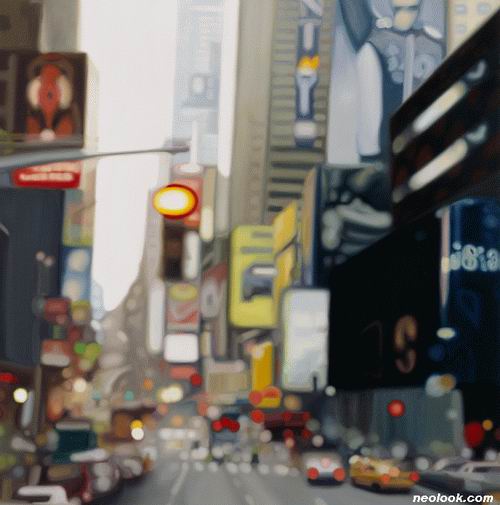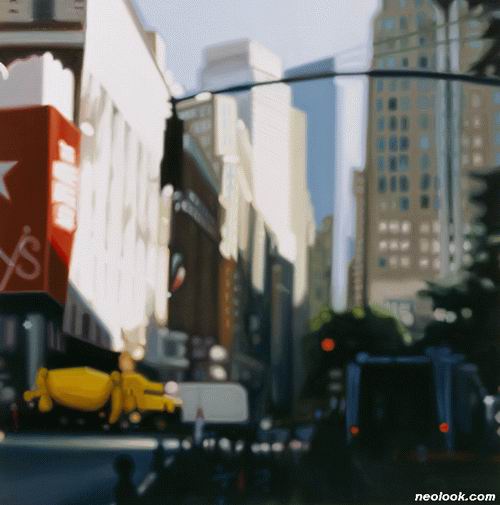- ● homepage
- ● archives
- ● restoration
- ● books
- ● big banners
- ● post board
- ■ neo's search
- ■ about us
- ■ 게재방법 안내
- 개인정보처리방침

- [email protected]
- Tel. 02_335_7922
- Fax. 02_335_7929
- 10:00am~04:30pm
- 월요일~금요일
- 3/3(월) 대체공휴일

New York
국대호 회화展 2007_0905 ▶ 2007_0920
● 위 이미지를 클릭하면 빛갤러리 홈페이지로 갑니다.
초대일시_2007_0905_수요일_05:00pm
빛갤러리 기획초대전
빛갤러리 서울 종로구 소격동 76번지 인곡빌딩 B1 Tel. 02_720_2250 www.vitgallery.com
혼성의 도시 풍경 ● 국대호는 새롭고 다양한 도시의 모습을 그려낸다. 작가는 프랑스 유학시기부터 귀국 후 처음 몇 년은 (1996년에서 2001년에 이르는 시기에는) 여러 색면을 병렬적으로 위치시키는 색채 추상을 그려왔다. 그 시기의 작품은 하나의 캔버스 위에 한 색으로 제시되어, 평평한 모더니스트적 '사각'의 개념이 강조되어 보였다. 그러나 2003년에 이르러 그의 작품은 변화된 모습을 보이기 시작한다. 그는 색과 색 사이의 섬세한 '사이의 색'을 제시함으로써, 과거의 평면적인 단일한 색면이기보다는 색의 '뉘앙스'를 보여준다. 변화가 있는 색을 하나의 색으로 고정함으로써, 구체적으로 한정된 '단어'와 같은 불변의 색보다는 '변화하는 색상과 명도'를 보여주는 변화의 색 단계로, 이러한 '사이의 다양성'은, 예를 들어, 빨강과 파랑 사이의 면들을 만들어낸다. '뉘앙스'는 다양한 단계와 정도를 갖는 것으로서, '단일한 유일성'과 '통일성'을 지양하며, 변수(x)처럼 다양한 변화를 갖는 존재의 위상을 갖는다. ● 이러한 '변수'의 색면들은 더욱 발전하여, 이번 개인전에서 제시되는 일련의 작품 'New York'연작에서 구상과 비구상 사이의 중간의 형태를 그려낸다. 예를 들면, 작품「Times square-02」은 뉴욕의 'times square'를 보여주는데, 형태들은 매우 희미하게 제시된다. 이러한 희미한 형태는 분명한 형태와는 다르게 대상의 외곽을 열어 놓고, 일반적인 대상의 의미를 부정하거나 회의하게 한다. ● 사실 그의 작품은 몇몇 작가들과 유사성이 있다. 우선, 그의 작품을 고진한의 '근시안적 풍경'과 비교할 수 있다. 국대호의 이미지는 과거의 '변수'처럼 제시되는 뉘앙스의 색상에서 발전되어 온 형상을 보여주는 열린 색면으로 '세계'를 덜 구상적-비구상적이게 하는 형상이다.

- 국대호_Chelsea-01_캔버스에 유채_89×130cm_2007
고진한은 그리는 대상보다, 앞선 공간에 초점을 잡아, 대상을 희미하게 그리는데 반해, 국대호는 카메라의 '초점'이 잡히지 않는 현상에 주의하여 작품을 시작한다. 이것은 '보케(Bokeh) 현상'으로, 특히, 야경의 조명이 망점처럼 퍼져 보이는 효과에서 찾을 수 있다. 이러한 기계화된 시각을 통해서 세계를 보여주면서도, 또한 다른 시각의 새로운 변수를 만들어낸다. 이러한 보케 현상은 작가가 말하듯이 본인의 주관적인 시각과도 연관되면서도, 대상의 사실성 정도를 감소시킨다. 이것은 곧, 대상이 갖는 현실성의 정도를 빼어내며, 부분적인 추상성을 가미하는 것이다. 이렇게 그는 형상적인 작품을 하면서도 동시에 '추상적'인 시각을 만들며, 캔버스 안에 제시되는 이러한 대상의 형태를 시각적인 얼룩으로 보이게끔 한다. ● 그의 시도는 새로운 대상의 모습 속에 중간 인식의 길들을 연다. 세계에 대하여 인식한다는 것과 비 인식의 중간이라고 할 수 있다. 이러한 측면에서 윤종구가 보여주는 '희미한 형태'와 차이를 갖는다. 윤종구는 사진기를 통해 대상을 볼 때, 나타난, 모호함이나 경계를 이용하거나, 슬라이드 필름을 미세한 바람에 흔들리게 하여 그 움직임까지 투사하여, 형상을 분명하지 않은 형태로 제시한다. 이러한 시각은 대상에 초점을 잡는 것이 아니라 대상 너머에 초점을 두거나 '주체와 대상 사이 중간의 빈 공간'에 초점을 두어, 우리가 실제공간이나 평상시, 인식하지 못했던 주인 없는 공간, 사이의 빈 공간을 쳐다보게 한다. 윤종구는 '보통 때는 잘 안 보이는 공간'을 그리며, 지각은 대상 없는 지각과 대상 있는 지각 사이의 문제를 보려는 것이나, 국대호의 작품에서는 '도시'의 이미지가 주된 의미와 역할을 갖는다. 여기서 두 가지의 의미가 제시되는데, 하나는 도시의 희미한 실체를 통해 현대 도시의 새로운 풍경을 만든다는 특징이다. 국대호에게서 새로운 풍경으로서의 도시의 의미는 과거의 풍경으로서의 '자연'과는 매우 다른 사회적, 문화적, 정치적 경제적인 의미를 갖는다. 이때 제시되는 도시의 의미는 근대에 들어오면서, 새로운 위상과 역할, 의미를 갖는 '도시'이다. 도시는 '거대한 도시, 여러 도시들이 연결되는 현상으로서, 산업 도시와 주택지가 혼합되는 것'(Francoise Choay)으로 산업화라는 의미가 함께한다. 여기서 도시의 의미에 인간을 위한 유토피아를 제공할 수 있다는 매우 근대적인 인간관이 있는 인간중심적, 기계적, 모던니스트적 의미가 포함된다.

- 국대호_Times Square-02_캔버스에 유채_220×330.5cm_2007
이러한 측면에서, 작가는 도시를 찬양하는 긍정적인 시각을 찾을 수 있다. 그래서, '계획없는 도시구조'(그로피우스가 뉴욕을 보고 한 이야기)까지도 사람들이 이룩한 문명 결과로 생각하며 작가는 애정을 갖고 본다. 이 문명은 정신과 산업 등이 섞여 있는 것이며, 이것은 오히려 박물관화된 자연 밖에 현대 인간의 삶이 녹아있는 것이다. 여기서 작가는 그 정황의 의미, 도시적인 의미들, 그 속에 있는 삶과 경제, 기계문화, 도시의 구성과 역할 등의 의미들을 조심스럽게 반성하고 현대문명의 풍경화의 의미를 제시한다. ● 또한 그가 갖는 이러한 장소의 의미는 '여행지'라는 중요성을 갖는다. 여행지는 '움직'이고 변화하는 곳이다. 한 장소에서 다른 장소로 움직이고 변화한다. 이러한 장소는 시각이라는 단어의 의미, 구체적인 대상을 보여주는 의미를 반성하게 한다. 즉 작가가 제시하는 것은 '보여줌', '나타냄'을 뜻하면서도, 작가의 꿈이나 생각(visum)을 의미한다는 점에서, 양면의 모습을 이 visum의 의미로 해석할 수 있을 것이다. 조명 속에서 색점이 제시되는 것은 그러한 측면에서, 대상을 이해하려는 과정과 다르게 보려는 과정을 섞어놓는 것이라 할 수 있다. 이렇게 추상에서부터 시작된 그의 화력은 새로운 형상예술을 모색하는 노력으로 새 이미지를 찾아내고 있고, 그러한 점에서 앞으로 변화하는 화단의 새로운 '논의'를 이끌어 낼 것으로 믿는다. ■ 강태성

- 국대호_Times Square-01_캔버스에 유채_160×160cm_2007
The Landscape of Urbanism ● Daeho Guk portrays a new and different view of the city. He had worked on color field painting which parallels a variety of color planes during his study in France and for the first few years since he came back home (from 1996 to 2001). During the period, his paintings seemed to emphasize a flat and modernist concept because they were described in one color on the one canvas. Around 2003, his works began to undergo some changes. The artist shows a 'nuance' of color rather than a single plane color field by demonstrating 'color of between, as like inter-color between two objects'. He does not leave the colors fixed. His works show the changing steps of color revealing 'altering color and brightness', not unchanging color like a concretely defined word. The 'diversity of between' creates, for example, fields between red and blue. The 'nuance' contains various stages and levels, searches for 'single uniqueness' and 'unity', and reaches a position of a variable x by going through diverse changes. ● The color fields of a variable x expand more and create medium form of figurative art and non-figurative art in the New York series presented in this solo exhibition. For example, 'Times square-02' pictures the Times square by showing vague forms. The vague forms unlock the external features of the objects, and deny or doubt the meanings of the ordinary objects. ● Daeho Guk's works are similar to several other artists'. His paintings can be compared with Jinhan Ko's 'near-sighed landscape'. His images are open color planes describing gradual stages of color of nuance like a variable, making the 'world' less figurative and non-figurative.

- 국대호_32nd St-01_캔버스에 유채_35×85cm_2007
Jinhan Ko describes the objects vaguely by placing the focus on the front space while Daeho Guk pays attention to the phenomena not caught in the focus of the camera. This is called 'Bokeh' and can be found in the effects of halftone dots making the night view spread out. The mechanized angle not only mirrors the world but also creates new variables of different perspective. As he says, the Bokeh phenomenon is linked to his subjective perspective and minimizes the reality of the objects. In other words, it subtracts the reality from the objects and adds abstractness partially. He delivers realistic works, but creates 'abstract' expressions at the same time. His objects are pictured as visual spots on the canvas.

- 국대호_Seventh Ave-01_캔버스에 유채_100×100cm_2007
Daeho Guk's attempts open the ways to in-between positions in new features of the objects. He stands in the middle between the awareness and non-awareness of the world. In this sense, His paintings are different from the artist Jong gu Yoon's 'vague form'. Yoon describes the objects vaguely by using their ambiguity or boundaries reflected in the camera, or letting the slide films wave in the wind and projecting their movements. He places the focus on the other side over the objects or 'empty space in the middle between subjects and objects. His style makes us look at the vacant space. It is the real place, but unoccupied in-between space we do not usually realize. The spaces in Mr. Yoon's painting are 'not visible at ordinary times'. He deals with the problems between perception with objects and without objects. However, the image of 'city' plays a primary role in Daeho Guk's works, and conveys important meanings. He creates new landscapes of modern cities through vague expression of real cities. The city revived as new landscape possesses totally different social, cultural, and political significance, compared with the 'nature' as the old landscape. It reflects the image of the modern city with new status, roles, and meanings. The city means industralization because [The society] "produces metropolis, conurbations, industrial cities, grands ensemble of habitation"(Francoise Choay). The city also contains the humanistic, mechanized, modernistic meaning, that is, the modern view of human that the city can provide utopia for human.

- 국대호_NY Taxi_캔버스에 유채_50×65cm_2007
In this aspect, Daeho Guk discloses the positive viewpoint that 'praises the city'. He looks at the 'chaotic disorganization of our towns' (what Gropius said about New York) with warm eyes and regards it as the glorious outcome of human civilization. The civilization is a mix of spirit and industry. The lives of modern men are melted in the civilization while the nature turned into useless museum. The artist carefully explores the meanings of cities, lives and economy melted in cities, machine civilization, and the structure and roles of cities. He also shows the significance of the landscape painting that describes modern culture. ● His places are also important because they mean 'travel destination. The destination of the journey is the place of 'movements' and changes. People change and move from one place to another place. It let us reconsider the implication of the word 'vision' which means showing specific objects. In other words, what the Daeho Guk presents means not only 'showing' and 'expressing', but also his dreams and visum. In this sense, the color dots in the lights can be interpreted as a mix of the process of understanding the objects and observing them from different angle. His zeal for paintings that started with abstractness is moving toward new figurative art, discovering new images and will draw new discussions from the artistic circles. ■ Taisung Kang
Vol.20070909b | 국대호 회화展

